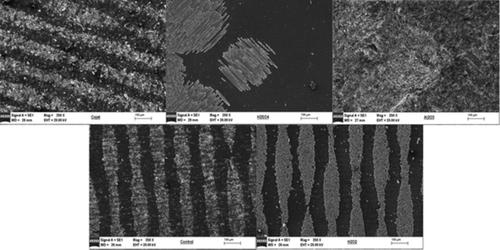当前位置:
X-MOL 学术
›
Polym. Int.
›
论文详情
Our official English website, www.x-mol.net, welcomes your
feedback! (Note: you will need to create a separate account there.)
Effect of surface treatment on roughness and bond strength of CAD-CAM multidirectional glass fiber-reinforced composite resin used for implant-supported prostheses
Polymer International ( IF 2.9 ) Pub Date : 2021-01-10 , DOI: 10.1002/pi.6173 Işın Kurkcuoglu 1 , Cenker Kucukesmen 2 , Serhat Emre Ozkir 3 , Burak Yilmaz 4, 5
Polymer International ( IF 2.9 ) Pub Date : 2021-01-10 , DOI: 10.1002/pi.6173 Işın Kurkcuoglu 1 , Cenker Kucukesmen 2 , Serhat Emre Ozkir 3 , Burak Yilmaz 4, 5
Affiliation

|
The study evaluated the effect of different surface treatments on the surface roughness of a new-generation fiber-reinforced CAD-CAM composite resin (FRC) and its bond strength to veneered composite resin. Fifty specimens (10 mm × 10 mm × 1 mm) were prepared from FRC blocks (Trinia; Shofu) and embedded in acrylic resin. The specimens were divided into five groups (n = 10) for different surface treatments: nontreated (control), Al2O3 airborne particle abrasion, silica coating (Cojet), acid etching (H2SO4) and hydrogen peroxide (H2O2) application. Surface roughness (Ra) of the specimens was measured using a profilometer. A veneering composite resin (3 mm in diameter by 4 mm in length) was applied on the specimens. The shear bond strength between the FRC and the veneering resin was measured. A one-way analysis of variance was used to analyze the data. The differences among the groups were analyzed with Dunn post hoc tests (α = 0.05). Surface treatments increased the surface roughness, and Al2O3 airborne particle abrasion resulted in the highest Ra value followed by H2SO4, Cojet, H2O2 and control group (P < 0.05). The highest shear bond strength was achieved with Al2O3 application (P < 0.05). Cojet and H2O2 applications resulted in higher shear bond strength than the control (P < 0.05). H2SO4 application resulted in lower bond strength than the control (P < 0.05). Surface treatments increased the surface roughness of FRC. Al2O3 and silica coating increased the surface roughness more than the chemical applications. The tested surface treatments can be used to increase the bond strength except for the H2SO4 application. © 2021 Society of Chemical Industry
中文翻译:

表面处理对种植体支持假体用CAD-CAM多向玻璃纤维增强复合树脂粗糙度和粘结强度的影响
该研究评估了不同表面处理对新一代纤维增强 CAD-CAM 复合树脂 (FRC) 的表面粗糙度及其与贴面复合树脂的粘合强度的影响。用 FRC 块(Trinia; Shofu)制备 50 个试样(10 mm × 10 mm × 1 mm)并嵌入丙烯酸树脂中。将样品分为五组(n = 10)进行不同的表面处理:未处理(对照)、Al 2 O 3空气传播颗粒磨损、二氧化硅涂层(Cojet)、酸蚀刻(H 2 SO 4)和过氧化氢(H 2 O 2 ) 应用。表面粗糙度 ( R a) 的样品使用轮廓仪测量。将饰面复合树脂(直径为 3 毫米,长度为 4 毫米)涂在样品上。测量了 FRC 和饰面树脂之间的剪切粘合强度。使用单向方差分析来分析数据。使用 Dunn post hoc检验分析各组之间的差异(α = 0.05)。表面处理增加了表面粗糙度,Al 2 O 3 气载颗粒磨损导致最高的R a值,其次是H 2 SO 4、Cojet、H 2 O 2和对照组(P < 0.05)。Al 2 O 3应用达到最高剪切粘合强度(P < 0.05)。Cojet 和 H 2 O 2应用导致比对照更高的剪切粘合强度(P < 0.05)。H 2 SO 4应用导致粘合强度低于对照(P < 0.05)。表面处理增加了 FRC 的表面粗糙度。Al 2 O 3和二氧化硅涂层比化学应用增加了更多的表面粗糙度。除 H 2 SO 4外,经测试的表面处理可用于增加粘合强度应用。© 2021 化学工业协会
更新日期:2021-01-10
中文翻译:

表面处理对种植体支持假体用CAD-CAM多向玻璃纤维增强复合树脂粗糙度和粘结强度的影响
该研究评估了不同表面处理对新一代纤维增强 CAD-CAM 复合树脂 (FRC) 的表面粗糙度及其与贴面复合树脂的粘合强度的影响。用 FRC 块(Trinia; Shofu)制备 50 个试样(10 mm × 10 mm × 1 mm)并嵌入丙烯酸树脂中。将样品分为五组(n = 10)进行不同的表面处理:未处理(对照)、Al 2 O 3空气传播颗粒磨损、二氧化硅涂层(Cojet)、酸蚀刻(H 2 SO 4)和过氧化氢(H 2 O 2 ) 应用。表面粗糙度 ( R a) 的样品使用轮廓仪测量。将饰面复合树脂(直径为 3 毫米,长度为 4 毫米)涂在样品上。测量了 FRC 和饰面树脂之间的剪切粘合强度。使用单向方差分析来分析数据。使用 Dunn post hoc检验分析各组之间的差异(α = 0.05)。表面处理增加了表面粗糙度,Al 2 O 3 气载颗粒磨损导致最高的R a值,其次是H 2 SO 4、Cojet、H 2 O 2和对照组(P < 0.05)。Al 2 O 3应用达到最高剪切粘合强度(P < 0.05)。Cojet 和 H 2 O 2应用导致比对照更高的剪切粘合强度(P < 0.05)。H 2 SO 4应用导致粘合强度低于对照(P < 0.05)。表面处理增加了 FRC 的表面粗糙度。Al 2 O 3和二氧化硅涂层比化学应用增加了更多的表面粗糙度。除 H 2 SO 4外,经测试的表面处理可用于增加粘合强度应用。© 2021 化学工业协会











































 京公网安备 11010802027423号
京公网安备 11010802027423号